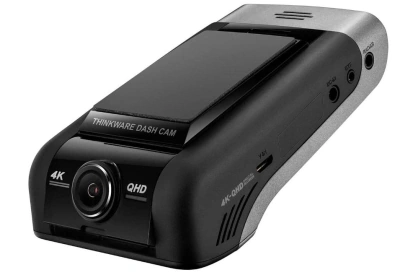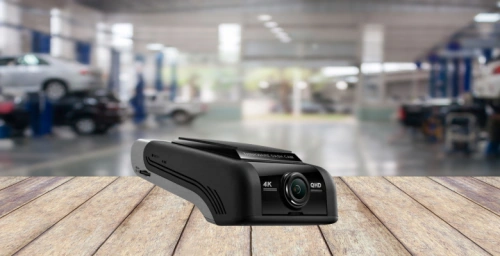Drivers looking to install the best dash camera in their car often wonder about the difference between the BlackVue DR900X vs Thinkware U1000, two top-quality systems. With a dash cam, you’ll capture footage of the events leading up to an accident. You can even configure a dash cam to automatically record when someone tries to break in.
The two cameras are very similar, but the feature that makes the difference is accessing videos. The BlackVue DR900X is a better buy than the Thinkware U1000 because accessing videos and settings is easier (>>> Find on Amazon).
Blackvue DR900X vs Thinkware U1000 side by side:
 |  | |
|---|---|---|
| Blackvue DR900X | Thinkware U1000 | |
| Resolution (front) | 3840×2160 30FPS | 3840x2160 UHD 30FPS |
| View angle | 162 degree | 150 degree |
| Built-in Wi-Fi | Yes | Yes |
| Built-in GPS | Yes | Yes |
| LTE Module | Yes | No |
| Maximum capacity | 256 GB | 128GB |
| Price | Find on Amazon | Find on Amazon BHPhotoVideo.com |
BlackVue DR900X

This is a two channel system from industry-leader BlackVue. The DR900X is the newest offering from the company and it sports some impressive technology. The front camera records video at 4K UHD using an 8 megapixel camera and an advanced CMOS sensor. The rear camera records at 2K resolution. Both front & rear cameras operate at 30 FPS to provide smooth video.
One of the features we like about the BlackVue camera is that setup is so easy. The angle of the camera is adjustable, so placing the device in the correct location is straight-forward. Setting up the rear camera is similarly simple. The hardest part of the installation is routing the rear camera cable back to the front which requires removing interior trim.
Where the BlackVue system starts to set itself apart from competitors is in the way videos are compressed and stored. Using advanced coding, 4K video files are compressed by 50%, allowing you to get as much as 4 hours of video on the included 32 mb SD card. That means you can get a lot of videos on a card before it starts to overwrite.
The real reason the BlackVue system is preferable is because of the app. It’s slick, simple, and intuitive to use. You can easily find all the important settings for the cameras, download and view videos, and even check in on your vehicle in real time when you have the parking mode enabled. For our full review of the BlackVue DR900x click here
Key Features
- Front 8.1-megapixel CMOS sensor 4K UHD, 3840×2160 resolution @ 30 FPS
- Rear 2-megapixel Sony STARVIS sensor 2K HD, 1920×1080 resolution @ 30 FPS
- High Efficiency Video Coding
- View video and live recording via Cloud
- Hardwire included for Parking Mode
- LTE Connectivity available separately
Pros
- Super smooth video files
- Easy install, setup, file viewing
- Attractive design that easily hides behind a rear view mirror
Cons
- Optional battery pack to prevent parking mode battery drain is expensive
- No option to disable parking mode
Thinkware U1000 Review

Like the BlackVue above, this is a dual camera system that includes a front and rear camera. The front cam is an 8.42-megapixel unit that records video in native 4K at 30 FPS or can capture 2K at 60 FPS for easier license plate reading. The rear camera captures video at 2k resolution at 30 FPS. If this had been just between cameras, the Thinkware would have been the winner, but that is only part of the story.
Installation is a bit more of a hassle with the Thinkware U1000 due to the limited adjustability of the camera once installed. If you don’t get the adhesive pad in place correctly you’re sort of stuck with it. Other than that, installation is on par with similar systems, the most time-consuming part being routing the rear camera feed.
The Thinkware app is what really made a difference. Many reviewers say that it seems as if Thinkware was trying to cram too much into the app, and the overall effect is clunky, glitchy, and difficult to navigate. To put it simply, the BlackVue app is more polished and applicable to a product at this price point.
The other issue we had with the Thinkware design is compression of the video files. The files are massive in 4K, chewing up a 32 gb card in less than an hour. That doesn’t provide very much assurance when you need to pull a video from the other day. The difficult to use app didn’t make it any better, either.
Key Features
- Front 8.42-megapixel Sony STARVIS sensor 4K UHD 3840×2160 native resolution @ 30 FPS, reducible to 2k @ 60FPS
- Rear 2-megapixel CMOS sensor 2K HD 2560×1440 resolution @ 30 FPS
- View recorded and live video via Cloud
- Optional Parking Mode
Pros
- Excellent quality cameras with high resolution and variable frame rate capture
Cons
- App is not good enough for the price of the product
- Lack of adjustment once camera is placed results in many people having to take additional steps to reinstall the camera
- Parking mode automatic shut-off doesn’t always work, which drains the vehicle battery
Conclusion
There are more similarities between these two cameras than differences. The biggest difference really came down to convenience. It’s just simpler, faster and easier to use the BlackVue app than the Thinkware software. Overall, if the apps had been comparable, this one would have been a difficult call. When viewing the 4K images from the Thinkware on a 4K TV or monitor, the quality is breathtaking. We did notice some significant pixelation when viewing those same videos on a 2K screen. The BlackVue images seem clean, clear, and easy to see, though the difference in image quality between 4K and 2K is noticeable on the appropriate monitor. (>>> Check on Amazon)
File compression was a big deal for us, as we need a camera that can record for a decent amount of time without having to download videos we want to keep. Of course, upgrading to a larger capacity SD card would help out with handling the over-sized files created in 4K resolution, but that wouldn’t have been a fair comparison between the BlackVue DR900X vs Thinkware U1000.
REFERENCES AND FURTHER READING:
- Blackvue DR900x vs. DR900s Comparison
- https://garagegeektips.com/blackvue-dr750x-vs-dr900x/
- Thinkware U1000 vs Blackvue DR900X Plus
